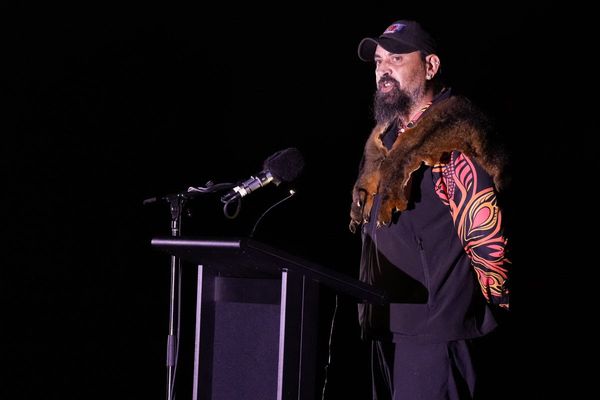
The jet, horn, silver and coral amulets placed around the neck of a three-year-old boy in Tàrrega almost seven centuries ago offered no protection against the crowds who massacred him and hundreds of other Jews in the Catalan town in 1348.
Some of the other pieces in a new exhibition at Madrid’s Prado museum that looks at how images were used to shape and define relationships between Jews and Christians in medieval Spain may have been more effective in warding off the escalating antisemitic hatred.
The crudely carved piece of vine trunk dug up by a Jewish man in Toledo 50 years later, a wild and disturbing representation of the crucified Christ, certainly proved potent. Not only did its discovery lead the man to convert to Christianity – a wise move given the recent pogroms – but the effigy itself also went on to become an object of veneration for rain-starved winemakers.
And then there is the possible protection afforded by the painting of an austere Christ that the priest Juan López commissioned from the early Renaissance artist Antoniazzo Romano around 1495. López – who was from a family of conversos, or Jews who had converted to Catholicism – fled to Rome to escape accusations of crypto-Judaism, or secretly maintaining his ancestral religion. As the catalogue notes, ordering the piece may have helped López underline his Christian devotion and dispel suspicions about his loyalties.

The exhibition, The Lost Mirror: Jews and Conversos in Medieval Spain, features 71 works – among them paintings, haggadahs, sculptures, illuminated manuscripts and the vine stump – from about 30 churches, museums, libraries, archives and Spanish and international collections.
Taken together, they chronicle the shifting lenses through which Spain’s Catholics saw the country’s Jewish population between 1285 and 1492. As the title suggests, the show also explores how, as time went on, Catholic Spain propagated the otherness of its Jewish inhabitants as a means to affirm, forge and galvanise a Christian identity. “The relationship between the Christian and Jewish communities in the middle ages is one of the key themes in the history of our country,” said Miguel Falomir, director of the Prado. “If ever there was an exhibition that showed how vividly and eloquently images can be used, then this is it.”
Noble portrayals of Old Testament prophets give way to depictions of Jews as wilfully blind – and often literally blindfolded – before the divinity of Christ. By the late 13th century, something more sinister is under way: an illuminated parchment created around 1280 shows a Jew stealing an icon of the Virgin Mary in Constantinople and dropping it into a latrine. The offending Jew is killed by the devil, but the icon survives its fetid dip and remains fragrant, thereby prompting the local Jewish community to convert to Catholicism.
Fast forward 100 years and an altarpiece shows a Jew – who has been given a communion wafer by a Christian woman hoping to get back her pawned dress – profaning the bleeding, if miraculously resilient, host. According to the exhibition’s curator, Joan Molina, head of Spanish Gothic art at the Prado, the increasingly “militant and virulent” brushstrokes came to mirror the beatings, hackings and burnings.

“In the 14th century, there was a systemic violence against the Jews and that’s when we see series of images that are conceived as expressions of anti-Jewish feeling,” he said. “But we need to realise that they are above all a means of building Christian ideas and beliefs: they are images that underline and reinforce the Christian identity.”
Although the pogroms of 1391 led to a mass conversion to Catholicism, hatred and suspicion of Spain’s Jews was by then so thoroughly entrenched that an additional enemy was identified in the figure of the converso. Blood libels – the most famous of which was the Holy Child of La Guardia, in which a group of conversos and Jews were accused of crucifying a Christian child and using his heart for ritual purposes – abounded and were gladly stoked by inquisitors in search of crypto-Jewish heretics.
Perhaps the image that best represents the centuries of antisemitism that culminated in the expulsion of the Jews from Spain in 1492 is the one that inspired the exhibition.
A few years ago Pedro Berruguete’s painting of St Dominic presiding over the auto-da-fe of five conversos – two burn alive while three wear sambenitos – caught Molina’s eye. He realised that as well as being a historical piece, it was “a promotional piece; a piece of Catholic propaganda” for the Spanish Inquisition, which had been set up in 1478 to root out and destroy heretics.

While Molina stresses that the exhibition is intended to show how images and tropes were used to build and strengthen one particular identity by othering and demonising another, he points out that the strategy is neither distant nor obsolete.
“What we’re talking about here are issues of intolerance,” he said. “Intolerance has always existed.
At the end of the exhibition there are works that refer to the Holy Child of La Guardia and the ritual murder of a child. But in the US at the moment, you have QAnon supporters and others who believe that Democrats drink the blood of stolen children. Intolerance doesn’t just belong to the middle ages – we see it in 2023, too.”
For all the talk of the Middle Ages as a dark time, he added, “I think our own time is just as dark – or just as bright. The idea is to show how this intolerance was used – and how these images were used to look at others in a certain way in order to confirm our own selves.”







